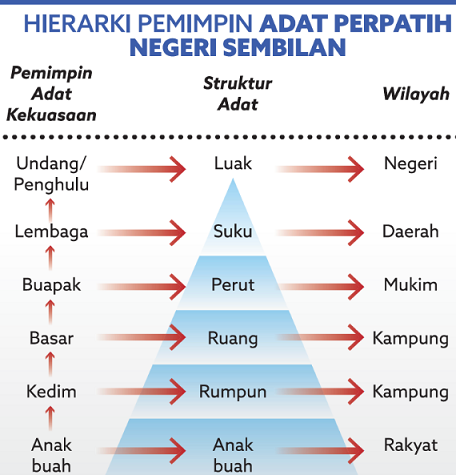Introduction of Adat Perpatih
Adat Perpatih (Matrilineal Custom) represents a form of lifestyle that is older than the English Common Law, which originated on around the year 1066 AD. Adat Perpatih originated in the Minangkabau world. It was introduced into Negeri Sembilan by the emigrants who opened up this province around the 12th century. Adat Perpatih was practiced by the rural community in the hinterland of Negeri Sembilan. It has been modified over time. However, the core element of this system continues to exist to this day
The Minangkabau customary laws have gone through different phases, namely the Undang-undang Nan Tigo (The Three Laws), “Adat Tarik Baleh” and “Adat Tuah Disakato” compiled by “Datuk Perpatih Nan Sebatang”. A dual lineage system came to exist:
- patrilineal system (associated with “Datuk Ketemenggungan”)
- matrilineal system (associated with “Datuk Perpatih Nan Sebatang”).
Following this development of two systems, there came to exist a new concept “Laras Nan Dua”, i.e Bodi Cianago and Kota Piliang. Through consensus, they decided to bridge their differences. They created a new system, the “Adat Tuah Disakato”. The landmark for this agreement I sthe “Batu Batikam” and “Batu Baling”. The two systems were unified, and came to be known as the “Adat Alam Minangkabau”, which is prevalent to this day.
In Negeri Sembilan, the Adat Alam Minangkabau is known as the Adat Perpatih. The Adat Perpatih regulates the life of the local community by prescribing the principles of harmonies living (the observance of moral etiquette), adherence to law and legitimacy of the ‘adat’, importance of landed property, family and respect for nature and other aspects of life.
Adat Perpatih is a complete social system. This system is not static but dynamic, as it provides space, opportunities and provisions for improvement according to changing times and situation. The dynamism of this custom is poetically enshrined in its constitution as follows:
‘Every good is accepted through consultation,
The bad is jettisoned through discussion,
There is nothing murky that cannot be cleared,
There is no complication that cannot be settled.
The old can be renewed,
and the leak can be mended.
Once there is flood,
the river bank changes,
Once the king dies,
the adat will change too,
Once the year changes,
the seasons also change.’
Leadership in the Adat Perpatih Community
The Adat Perpatih Community is divided into various family groups, which are known as “suku” which comprises; the “perut”. The ‘perut’ in turn embrace the “ruang”. The ‘ruang’ embraces the ‘rumpun’. Each family group has its own leader who is known as:
- ‘Kodim’, the head of “rumpun” (sublineage)
- “Besar” or ‘tua ruang’, the head of the ‘ruang’ (lineage)
- Buapak, the head of the “perut” (subclan)
- Lembaga, head of the “suku” (clan).

| Clans (suku) in Negeri Sembilan | ||
| Biduanda | Paya Kumboh | Tanah Datar |
| Batu Hampar | Tiga Nenek | Anak Acheh |
| Mungkal | Sri Melenggang | Anak Melaka |
| Sri Lemak | Batu Belang | Tiga Batu |